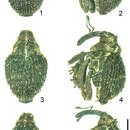Description
provided by Zookeys
LB: 2.18–2.66 (mean, 2.41). LR: 0.96–1.11 (mean, 1.03). WP: 0.94–1.08 (mean, 1.01). LP: 0.78–0.97 (mean, 0.86). WE: 1.48–1.79 (mean, 1.61). LE: 1.50–1.82 (mean, 1.64). N = 10 for all measurements. Habitus as shown in Figs 1–2.
Vestiture. Clavate scales short and semirecumbent on head, basal 2/3 of rostrum, and pronotum. Hair-like scales fine and semirecumbent on apical 1/3 of rostrum. Scales on elytral intervals (Fig. 35) semirecumbent, short, 0.4–0.8 × as long as interval width. Clavate scales on tibiae semierect.
Rostrum (Figs 22–23) slender, 1.15–1.24 × as long as pronotum; apical part of sides slightly widened and 1.14 × as long as basal part. Antennae (Fig. 23) with length ratio of funicular segments I: II: III: IV: V: VI = 1.89: 1.44: 1.36: 1.00: 1.17: 1.00 and width ratio = 1.71: 1.00: 1.21: 1.29: 1.50: 1.64.
Pronotum (Fig. 34) 1.12–1.21 × as long as wide, 0.51–0.54 × as long as and 0.60–0.66 × as wide as elytra; subapical constriction moderate; sides slightly widened from base to basal 1/3, faintly narrowed to middle, then gradually convergent toward apex.
Elytra 0.98–1.07 × as long as wide, 1.87–1.97 × as long as and 1.51–1.66 × as wide as pronotum, gently convergent toward subapical calli; humeral calli weakly prominent; subapical calli weakly prominent.
Underside. Metaventrite weakly prominent ventrally along apico-lateral margin of metaventral receptacle. Venter coarsely and moderately densely punctured; ventrite I with median prominence along apical margin; prominence weak, semicircular, densely and finely punctured; ventrite V with more or less shallow median concavity; length ratio of ventrites I: II: III: IV: V = 4.18: 2.00: 1.00: 1.14: 1.82 and width ratio = 1.96: 1.75: 1.32: 1.18: 1.00.
Pygidium transverse-pentagonal.
Terminalia and genitalia. Sternite VIII (Figs 44, 54, 64) diminished into pair of eye-shaped sclerites; spiculum gastrale robust, evidently longer than penis or its apodeme, bent leftward. Tegmen (Figs 43, 53, 63) with apodeme more or less stout, nearly 0.8 × as long as the diameter of the tegminal ring, more or less widened toward apex. Penis (Figs 40–42, 50–52, 60–62) broad, relatively thin in profile, more or less moderately curved downward in the basal 2/3, then slightly bent upward in apical 1/3; sides faintly narrowed from base to basal 1/3, slightly broadened from basal 1/3 to apical 1/5, then strongly convergent apically; apical projection blunt, rounded at apex. Basal part of endophallus (Figs 40, 50, 60) with pair of fig-like sclerites, numerous rounded spicules in median part, and moderately dense minute spicules in apical part.
LB: 2.28–2.67 (mean, 2.50). LR: 1.05–1.31 (mean, 1.19). WP: 0.95–1.11 (mean, 1.03). LP: 0.80–0.97 (mean, 0.89). WE: 1.54–1.89 (mean, 1.72). LE: 1.57–1.82 (mean, 1.72). N = 11 for all measurements.
Rostrum (Figs 24–25) slightly more slender, 1.27–1.36 × as long as pronotum.
Pronotum 1.11–1.20 × as wide as long.
Elytra 0.97–1.03 × as long as wide.
Underside. Metaventrite more strongly prominent ventrally along apical margin of metaventral receptacle. Ventrites I and II moderately inflated, sparsely punctured, lacking prominence. Ventrite V lacking concavity, with only longitudinal median sulcus that is sometimes obscure.
Pygidium smaller, fan-shaped.
Terminalia and genitalia. Tergite VIII (Figs 46, 56, 66) with pair of combs of dense, long setae along apical margin. Sternite VIII (Figs 47, 57, 67) with pair of patches of several minute setae near apex; arms relatively slender, nearly 0.8 × as long as apodemes, nearly half as long as coxite and stylus combined, slightly basally fused, and apically arcuate; apodemes slender, moderately divergent near apex. Bursa copulatrix (Figs 45, 55, 65) with dense minute coniform spicules in posterior part. Coxites (Figs 48, 58, 68) robust, subdivided into two pieces, nearly 7.0 × as long as styli; styli apicolaterally inserted, moderate in length, nearly 2.0 × as long as wide. Spermatheca (Figs 49, 59, 69) with cornu slender, strongly curved and slightly attenuate; collum slightly convex; ramus indistinct; insertions of duct and gland close to each other.
Otherwise as in male.
- license
- cc-by-3.0
- copyright
- Junhao Huang, Hiraku Yoshitake, Runzhi Zhang, Motomi Ito
- bibliographic citation
- Huang J, Yoshitake H, Zhang R, Ito M (2014) Taxonomic revision of the East Asian genus Scleropteroides Colonnelli, 1979 (Coleoptera, Curculionidae, Ceutorhynchinae) ZooKeys 437: 45–86
- author
- Junhao Huang
- author
- Hiraku Yoshitake
- author
- Runzhi Zhang
- author
- Motomi Ito
Distribution
provided by Zookeys
China (Liaoning and Heilongjiang – new record), Korea (North – new record, Central, South, and Ulreungdo Island), Japan (Hokkaido, Honshu, Izu Islands, Shikoku, Kyushu, and Tsushima Island) (Fig. 133).
- license
- cc-by-3.0
- copyright
- Junhao Huang, Hiraku Yoshitake, Runzhi Zhang, Motomi Ito
- bibliographic citation
- Huang J, Yoshitake H, Zhang R, Ito M (2014) Taxonomic revision of the East Asian genus Scleropteroides Colonnelli, 1979 (Coleoptera, Curculionidae, Ceutorhynchinae) ZooKeys 437: 45–86
- author
- Junhao Huang
- author
- Hiraku Yoshitake
- author
- Runzhi Zhang
- author
- Motomi Ito

